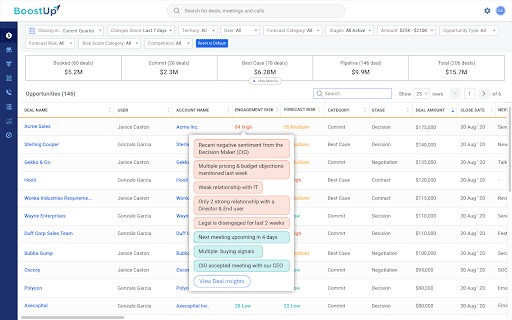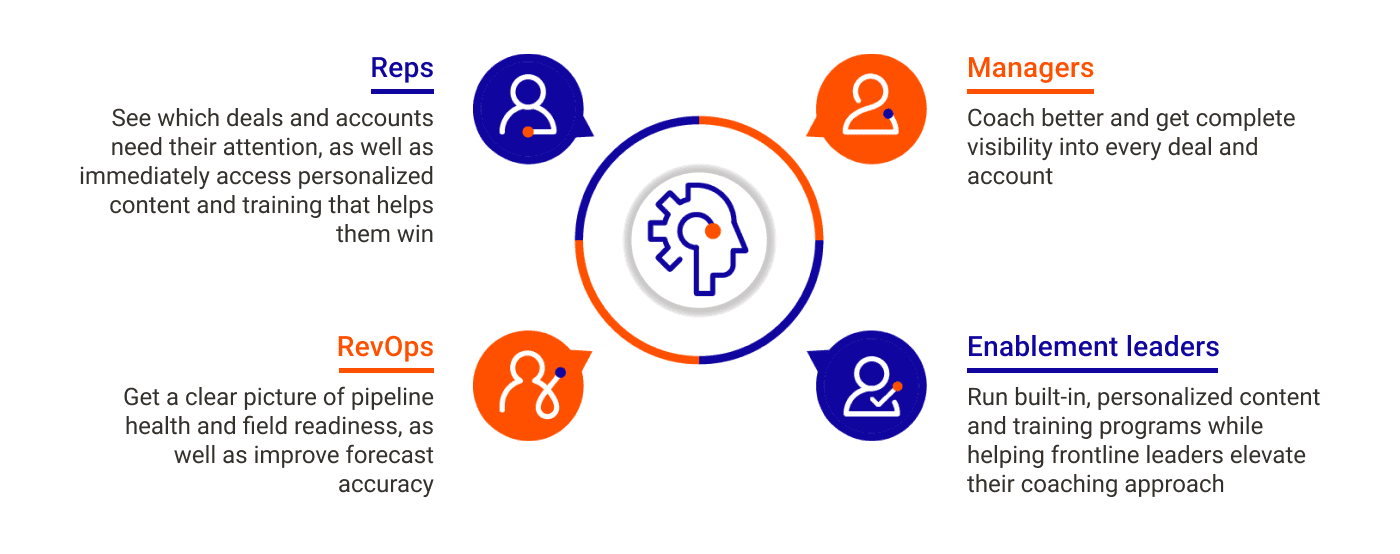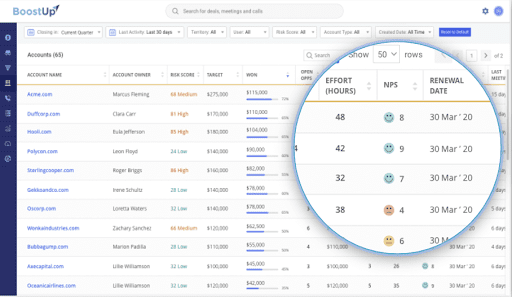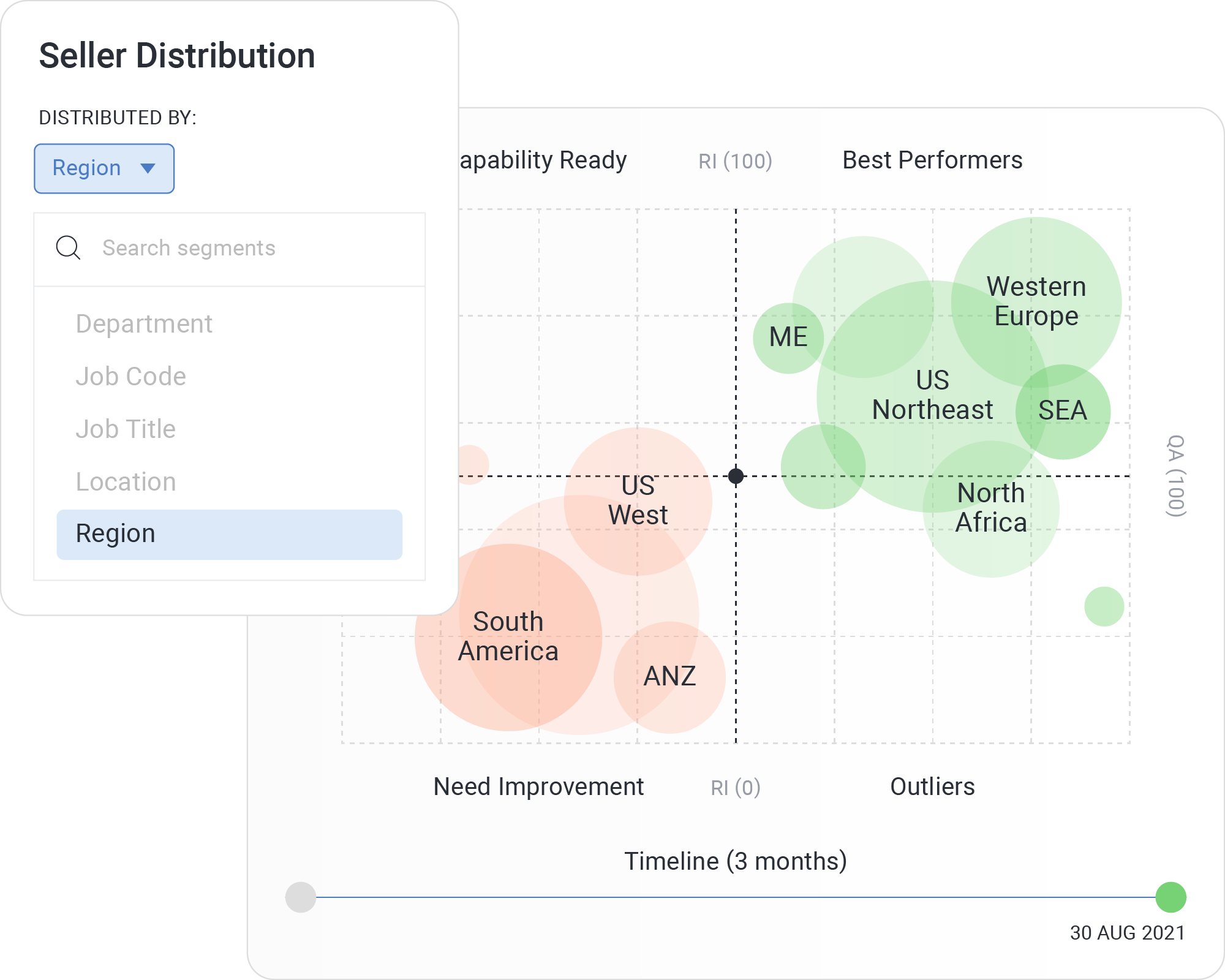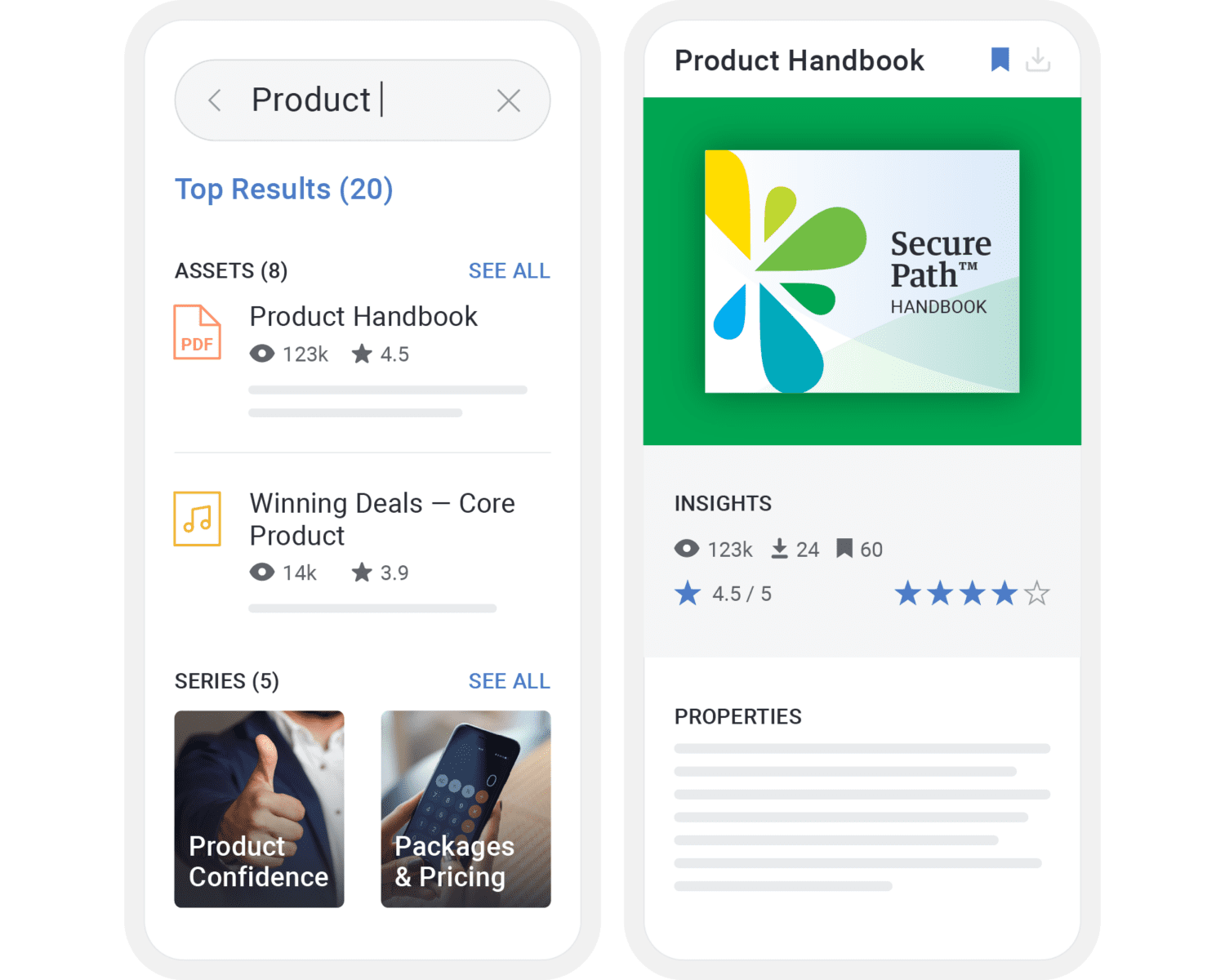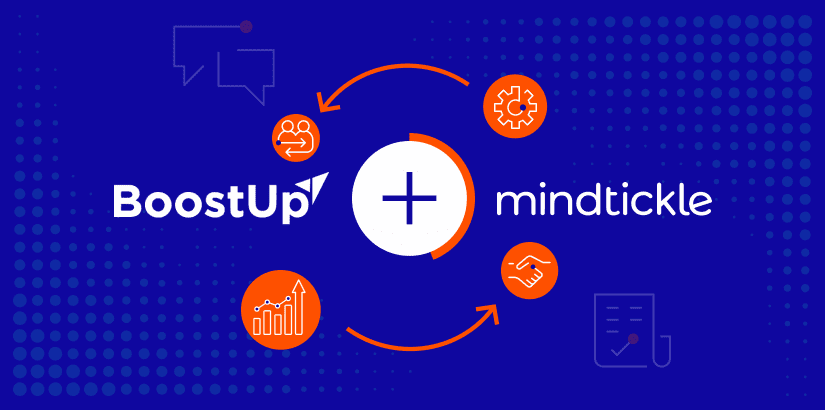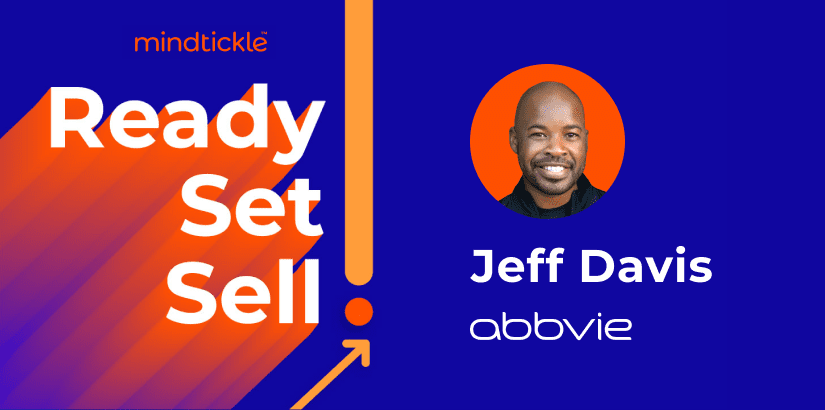Our seventh episode of Ready, Set, Sell recently aired featuring Jeff Davis, associate director of business and brand strategy at AbbVie and the founder and principal of Aligned Growth Strategies. In case you weren’t able to tune in, we’ve got a recap of the podcast below, covering major themes such as:
- The importance of strategically aligning sales and marketing
- Establishing a 360-degree view of the buyer
- Using digital tools to seamlessly engage your customer
- Retaining employee and customer attention
- The eight steps to digital-first selling
- Establishing a feedback loop from sales to marketing
- Metrics that matter more than closing deals
- NASA engineering and Dr. Suess
Who is Jeff Davis?
Tony: When it comes to finding success in any industry, pursuit, or discipline, perspective is everything.
Hannah: And, as today’s guest reminds us, having the capacity to understand multiple perspectives at once can be an invaluable skill in today’s market.
Tony: This is especially true for sales and marketing teams. In any organization, these two teams need to work together synergistically to produce the best results. But we all know that understanding the business through both a sales and marketing lens can be a challenge.
Hannah: That’s why I’m so excited about our guest today, who is Jeff Davis, the associate director of business and brand strategy at AbbVie and the founder and principal of Aligned Growth Strategies. Jeff has spent most of his career helping B2B leaders align their sales and marketing teams to optimize outcomes overall.
Tony: And he’s here with us today to share his top tricks of the trade when it comes to sales and marketing alignment, digital-first selling, and some of the key ingredients of accelerating revenue growth. You’re sure to walk away from this episode feeling more motivated than ever, inspired and knowledgeable more than ever before. Enjoy the episode.
Hannah: Hey, Jeff, welcome to the podcast.
Jeff: Hey, how are you? Thank you for having me.
Hannah: You need to bless the listeners with your incredible career journey and give everybody a bit of insight into how you went from being a mechanical engineer at NASA to transitioning into a technical healthcare sales role. I need to hear this.
Jeff: As you said, Hannah, I started my educational career at Purdue as a mechanical engineer. I always loved math and science. My mom actually was a math professor, so I couldn’t really be bad at math because that would look really bad. Right before I graduated, actually, I was interning at NASA and asked people what I should do with the rest of my life. Surprisingly, the two answers I got from the consultants we were working with was either sales or consulting, to which I said at the time absolutely not, because I just spent five years of my life getting this degree. I’m going to go be an engineer. But after undergrad, I actually took a leap of faith. I said, well, maybe they’re right. Right. You know, what’s the worst-case scenario? I can always go back to engineering. And so eventually ended up in healthcare sales. I’d always had an interest in healthcare and biotech and that sort of thing. And it actually stuck. Like, I really enjoyed it. I did well. I started my career at Pfizer as a rep here in Chicago. And I believe that a lot of the engineering process that I learned in school actually helped me be a successful salesperson. So, it all kind of came together.
Tony: Well, it’s funny, when I looked into your background, I got a little intimidated right away because I think you’re the first NASA engineer I’ve ever spoken to in person. I appreciate you joining here, of course. When you think about the world of B2B sales, what interests you the most and, in particular, about increasing revenue growth?
Jeff: It really does go back to the beginning of my journey. What I found as a rep is that there were many times that I felt there was a disconnect between us as boots on the ground and what marketing was doing. Back then — and industries have changed, and companies have gotten better at this— but it was very much an ivory tower. Like we said, strategy. If it doesn’t work, doesn’t happen. It’s the salespeople’s fault. And we’ll get to that in a second. But we would be frustrated because we’d be asking for things, and saying we really need to have these conversations. And, obviously, if you’re a seasoned salesperson, you can try to figure it out or you just make it on your own or whatnot but that’s not sustainable. At that time, that’s what motivated me actually to go back to business school because I didn’t have the language or the visibility to articulate what I was feeling. I knew something was off, I knew there was a disconnect. But at that vantage point, I’m only boots on the ground. I don’t see all the things that are happening, you know, behind the scenes. And so once I went back to business school, I transformed myself into a marketer, as I say, and then I joined the brand team as a brand lead.
And, you know, and I talk about this on my LinkedIn, I’m a marketer with the soul of the salesperson, right. Like I will always be at my core a salesperson. No matter where I go and what I do, I’ve been a marketer for years. But I got in selfishly to advocate for salespeople. I was going to go to the corporate office and tell them what reps needed and all that sort of thing. And when I got there and started working with super-smart people, I realized they just didn’t have the vantage point of being a seller. It wasn’t that they had like this goal to make our lives difficult or they didn’t care. They just didn’t have that last little step of like actually talking to a customer.
What I found was it wasn’t that sales and marketing hated each other. I believe they fundamentally don’t understand each other and that’s what causes conflict.
Hannah: Not everybody’s going to know who AbbVie are so I’d love for you to share a bit about your role at AbbVie and what drew you to that company in particular.
Jeff: At AbbVie, we’ve taken a really proactive approach to the fact that the industry as a whole has had to rethink what being patient-centric really is. Pharma tends to be a very conservative industry for many reasons. We’re making really significantly large investments in disease areas and therapeutic areas. But I think what we’re doing is rethinking what it means to be patient-centric — or customer-centric. Right. We have multiple customers. Their patients are the payers that we interact with.
So we’re looking at how do we leverage this kind of digital-first landscape in order to create increased intimacy with our customers and patients and really understand what they need and be able to engage them in a way that looks very different than we did a decade to three ago, because the world is different.
And if you really want to help people and you really want to get into their lives and help them understand what is out there that could potentially help save their life or make their life better. You’ve got to do it differently.
Hannah: I think it just goes much deeper when you start thinking about customer-centricity in general, something that we talk about a lot in the B2B space. So when you talk about patients and healthcare, it’s just much deeper. So thinking about your passion, your experience, and your love for counseling sales and marketing teams and creating alignment. Just, just go a little bit deeper. On why it’s so crucial for accelerating revenue growth.
Jeff: A lot of people will hang their hat on COVID and how that has changed things. And I absolutely believe that is true. But I think more than anything, it’s really brought to light some processes and things that were broken. It just made it worse. These themes, these issues that we’ve had have been brewing for quite some time, but a lot of us have relied on volume to mask the underlying infrastructure issues. Really today, because everything is so digital and because we’ve really been pushed into the future, it’s imperative that we change the way we sell and market. And a lot of companies are not realizing that the buyer is demanding a different experience.
And for some reason, we don’t look at our own personal lives, and interactions with B2C and see the parallel to B2B. We are humans buying from other humans. And while there are, there are unique things that are very B2C, right? I get that. But fundamentally, we as B2B should be looking at our B2C cousins and being like, how do we mimic that in our space?
Because people are getting more comfortable with buying larger purchases online. People do want more virtual human interactions. They don’t want traditional sales reps coming by as much, right? We have to take this hybrid approach. All of that stuff is happening. And I think a lot of revenue leaders and senior leaders that have been doing this for a really long time have been quite committed to saying yes, we fundamentally need to change the way that we go to market. That’s what’s causing some of this friction. And a lot of people seeing stagnant growth or declining growth are doing so because the way in which they’re engaging with the marketplace is out of date.
Tony: There are so many different things that you do, Jeff, from you know, you were a company founder, you’re a speaker, you’ve got a podcast, but you’re also an author. So in speaking about the book, you know, what is togetherness really mean to you and how can sales leaders use that to apply to their everyday roles?
Jeff: When I was in the early stages of my work, when I was just blogging, it hit me one day. And this is a\the true marketer in me, right? I was wondering about the ethos of what I’m trying to communicate. Togetherness can mean and does mean a lot of different things, but it is really beyond having skin in the game. It is a kind of omni joined presence where you always feel like you’re enmeshed with your counterpart. You can anticipate their needs. You have a strong sense of empathy because you know what their challenges are.
Tony: If you think about it, selling is a social event. I mean, people buy from people. And if you don’t take that concept to heart, you’re not really going to get to the next level of where you want to be in a successful organization.
Jeff: You are hundred percent correct. And we’re at a juncture where, as a revenue leader, whether it be sales and marketing, if you don’t fundamentally understand how much you need your counterpart, you are not going to be successful. Everybody is focused on the last 10, 20 percent of whatever it is of the buyer journey. Right. Some people say it’s 57, 75, 78, whatever, whatever the number is, we’ll say 57 to 75. If we’re all focused on that last 10, 15, 20 percent, we are just bombarding targets with the same stuff. And I said, There’s this open green pasture over here. Or they’re actually researching, they’re forming their ideas, they’re clarifying what their challenges are. And no one’s there. But you know who stereotypically is already there? Marketing. As a sales leader, your job is to get your people into the right conversations with the right type of accounts. That’s fundamentally your remit.
If you don’t understand what marketing is putting out into the marketplace and you don’t understand the messages and the story they’re telling, you are not doing your job as a sales leader.
Hannah: One thing you mentioned was that customers are demanding a different experience. And if I think about some of the conversations I have, I don’t even think they all know what that looks like. It just needs to be different. It needs to be more accommodating to their needs. Now, based on the fact that we are more virtual now, how would you start to define in your own words what digital-first setting is and why it’s important today?
Jeff: I look at it as using all of our digital tools, resources, etc. content to identify, target and really seamlessly engage today’s buyer. Right? To your point, we’re very much more enmeshed in digital. We’re always online. So we’re just using all these collective tools together to target, to identify, and then to engage with our buyers. Because the front end of this buying experience has become more virtual, more digital. People are starting their buyer journey with search. An estimated — I think — 80 plus percent or 90 percent of B2B buyers are starting their journey with digital search. Ninety percent is a lot. So think about that. If 90 percent of the people are starting there and this is just B2B. Ninety percent of people start on a journey digitally. If you’re not there, you’re not even making the shortlists companies are considering.
Finding one’s niche
Tony: So, Hannah, I talk to a lot of different salespeople. They’re always trying to find out what is the niche or what’s the market that I should be selling into or how should I do these sorts of things? So how did you find the niche in what you’re doing?
Hannah: That’s a really good question, actually. I think about this a lot because at the start of my career, I was, and you might have experienced this as well. There was a lot of structure. Like you had like one career path as a salesperson. It’s like you do some inbound stuff and you’re in the trenches and then maybe you have a little target and then you’re just on the road. That’s it. That’s what you do. And then maybe you’re a leader. And I think a lot of that’s changed. But I am I was following this path that was dictated by the industry for probably half of my career. I started to get a bit chill. I don’t know, something’s missing here. I don’t know what I should be doing, but I don’t know if I like this.
I started to transition more into mentoring and onboarding people and coaching and team leadership and leading a few teams. I like this, that this is what I enjoy. I kind of carved out that helping and enabling other people to be incredible sales individuals. This is really where my niche is but it took me doing everything. And I’m a massive doer. I’m like, there’s an idea. Someone says, try this. I just do it. I just do it and figure it out. So yeah, I had to do a lot of stuff and fail at some things to realize that actually, this is my sweet spot.
Tony: You know, it’s brilliant. When I graduated from college, I knew right away that I wanted to host a Ready, Set, Sell podcast someday. You know, this is well before podcasts were even a thing, but I fell into sales. It wasn’t anything that I thought was going to be my future career path. I started doing it to get beer money at the time. But I found out that I was empathetic, and I was good at it, and I was listening to what people wanted. I tried a couple of things that really didn’t work. And eventually, I found a niche that worked well for me. I was able to apply the things that I did well with my work ethic tied directly to it, and that just put me onto the path to where I am now — sitting here in a room with you. I couldn’t think of a better spot for me to be in my career right now.
Hannah: Tony, finding alignment between sales and marketing is an important step to take on the road to success. As Jeff reminds us, it’s really that simple.
Tony: Yeah, it is. And usually, a company’s senior leadership team, including the CEO, needs to be on board when it comes to major culture shifts and those that lag behind will ultimately lose out on opportunities for success.
Hannah: I think Jeff’s concept of togetherness really captures the need for greater empathy across the board and more effective communication among teams.
Tony: Absolutely. I think that’s key because, without a deep understanding of the organization’s needs, you won’t get far in the world of sales or marketing. Togetherness is about anticipating each other’s needs and recognizing the value of other roles within the organization… so we can really begin to view the company as a cohesive whole instead of as a fragmented jigsaw puzzle.
Hannah: And this has only become more important in recent years as the pandemic accelerated many of the shifts that were already in motion. Let’s hear what Jeff has to say about the shift to digital-first selling and how sales execs can make the most of the changes.
Eight steps to digital-first selling
Tony: Companies are still struggling to figure out their selling identity. You know, as people are starting to convert to this digital-first selling, what tips or strategies would you recommend people to think about as they’re really trying to develop this identity?
Jeff: I did an article for Selling Power where I go through the eight steps of digital-first selling. Can I bore your audience with these eight steps?
Tony: They will not get bored. I can guarantee.
Jeff: The first one is understanding the buyer-first mindset. Fundamentally as a leadership team, you’ve got to accept that the way that we buy is different. Like did a search first, digital-first, etc. The second one, which a lot of people overlook, is establishing a 360-degree view of the buyer. This means connecting all of your data sources. So that’s web, that’s email, that’s social, that’s your CRM. One of the reasons that we make very suboptimal decisions is because we have suboptimal data and we have a suboptimal view of the customer.
So if I’m a sales leader and I don’t really interact with marketing, I may not have visibility to all the touchpoints that we’ve had with that customer prior to my seller getting in front of them. All I have is what my seller has done, which is not the complete picture. We’ve got to connect all those resources. And whether you do it internally or you hire somebody out to do that, it’s got to be connected. Because today it is table stakes to have a full view of our customer interactions.
After we do that, then we want to develop a cross-functional ideal customer profile (ICP) because I’ve also seen companies have different ICP between marketing and sales. I’m like, That’s interesting. That’s not the same person. How is that working? So I need an aligned ICP across the organization and I don’t believe in creating that out of just how we feel. I want to look at your CRM. I want to look at closed deals. And I want to see proof that that is true because there are people that the ICP that we want to be true and there’s ICP that is true.
And then I also want to dig a level deeper and look at does that ICP provide us the most ROI? After we have our clarity in our ICP, then we need to develop a buyer’s journey. This is for marketers more so than salespeople. I don’t mean developing a buyer’s journey in a vacuum where we never actually talk to customers.
I mean, actually being really thoughtful and using all inputs like input from sales — like that last deal you closed, walk us through how that went. Where do you think that we can do things differently? And then actually talking to customers and saying like, tell us about your internal buying process.
You may get some people that love you and want to tell you everything. Others may not. But I want to talk to people that we love, that are amazing customers, maybe some mid-tier people, and maybe even those that we’ve lost so that we can start to understand how our buyer buys so we can adapt our sales and marketing to their process and not try to push them through what we want them to go through.
After that, I use what I call a buyer journey matrix where I actually put all of the info I collect for clients. I put all of the stages of the buyer journey. And then I want to litany what we have today that we can deliver on that so they get to the next level or the next stage. And that usually helps me find where there are gaps in your engagement with buyers. And they usually are clear. There’s usually a step. They’re like, “Oh, we really thought we had content or whatever around this, but we don’t.” Then we get to the tools and the tech.
So a lot of us are leading with tools and tech because there’s a nice shiny object in the room. And I say pause. Tech enables us to sell in market better. It is not sales and marketing. So after we get done with tech, then we create a digital sales playbook or a playbook for sales reps.
This is important because, back in my day, there was a very linear process. I did this and then I did this and then I did this and then hopefully close. That is not the case anymore because buyers are coming in from all over the place and sales reps today, in order to be successful, need to understand not the individual tools but how to orchestrate them together.
And then, last but not least, establishing a feedback loop from sales to marketing. Typically, I have seen marketing as a great feedback loop for sales. This is what’s working; this is what you’re doing right; this is what you’re doing wrong. But there’s usually not as robust a mechanism to get feedback from sales. And I don’t mean sales leaders, I mean actually front-line salespeople of what they need and then be able to take that in aggregate to say like, okay, here are the themes where we’re seeing from our sales reps as well as competitive intelligence. Because a lot of times I’ve had instances where you have a conversation with a customer and they tell you something like, “Oh, this starting to shift.” You get that back to marketing, we iterate, and then we can pivot in the marketplace.
So those are the kind of the eight steps that I’ve thought through and identified and helped my folks with. I think it’s a really, really clean framework because there’s a lot to do. But what I really focused on making sure that we understand who we are targeting first, we kind of really build that, that their strategy, we understand how they buy. And then you start to put on the tech and the and all the other stuff in order to able to enable that. So hopefully that was helpful.
Hannah: Thinking about these things and this transition that a lot of companies are trying to make, what are your top suggestions for teams who may be encountering some bumps along the road as they try to make this conversion?
Jeff: I always start with the conversation between sales and marketing. Where can we work together better? How can we partner with each other? What do you do? What are your challenges? I think starting there and understanding what your counterpart does and how what their work affects you is a great way to start. It increases empathy and it also helps you identify ways that you can work together better. And it may not, in the beginning, be a hundred percent right. It may be to your point, maybe it’s just reconciling your ICPs to make sure that you’re at least targeting the right people that my sales rep needs to get in front of. It could be establishing a feedback loop between sales marketing so that they know how they can pivot. It could be getting feedback from sales on the content. Is this content resonating? There are many marketing teams that create and develop content in a silo, like they just don’t get any real feedback. So I think that’s where you start.
I think you also start by trying to think about your digital presence as an organization beyond your brand.com. Right. The majority of the people are not coming to your brand.com as their first step. This is more for marketing and sales, but I think sales should be involved. Looking at your SEO strategy. Looking at your perception in the marketplace and third-party sites.
So, obviously, for SaaS software, G2 is a great place to start, right. Like a lot of people will start with search, they may go to G2 to learn about like the class of products that you sit in and then they’ll learn more about you. But if again, if you’re not in that kind of initial consideration, it’s going to be hard for you to make the shortlist.
I think those are some things you can start with. You know, you don’t have to go fundamental like we’re going by all this new tech and then we’re going to just do digital disruption. That would be nice, right. But for companies that are just starting this journey, it’s not realistic. So it’s about starting to work together better, really thinking through like, what is your digital, what is your digital footprint? And starting to elevate those eventually starting to connect all those things and really map those to the buyer’s journey. I think those are ways to start this process.
Hannah: Like looking at the big picture, what motivates you day to day? What’s the overarching goal that sort of drives you and get you out of bed on those rainy, cloudy days that I see in England every day?
Jeff: Yeah, well, in right in Chicago, it’s about the same right now. At the end of day, it’s frustration and I know it probably doesn’t sound like the answer that most people give, but I still remember as a sales rep in the car, on the road, being frustrated. And it still motivates me today. I think what has evolved is that I now feel like I have a commitment and a duty to help other sales and marketing leaders do it differently and do it better.
I fundamentally believe, and it’s happening more and more now, but back in the day, making a transition from sales into marketing was like parting the seas. They’d be like, you’re a sales rep and you want to be in marketing, well, that doesn’t work. But now that I’ve made that transition and I’ve seen the inside of both, it just really goes back to a marriage concept. If you understood the power of when you guys get each other and you work together, you can’t create these kinds of results on your own. Like you just can’t work in a vacuum or a silo and outdo a company even if they’re smaller. That really is lockstep. I would say frustration motivates me.
Tony: Well, it’s funny, frustration is certainly an issue that I think a lot of salespeople experience. I think another one is distraction, especially over the last couple of years. You know, when people are working from home it’s extremely easy to get distracted. What would you say were some tips that you would give to retain customer interest? I missed all the distractions that are out there right now. There are so many different things out there. So how do you retain employee or customer attention at this point?
Jeff: Consistency always wins. I have seen over the years so many people start campaigns and then, you know, you don’t hear from the can. You can put out okay content. But if you put out that content ecosystem basis and customers start to see you as a good source of information and you’re educating them on a consistent basis and they know they can trust it, you’re going to be there. You will win over somebody that does an amazing, splashy campaign and then goes away.
Hannah: If we think about these things that people these myths and these really weird misconceptions that do exist in B2B sales, what are some of the main ones that you’ve heard or seen in the sales industry that you wish you could put to rest for good?
Jeff: I would say that B2B sales is easy, like anybody off the street can do it. What you’re starting to see is that B2B sales, specifically tech, has become extremely complex. And so, you know, my buddy over Northern Illinois University, Dr. Robert Peterson, is an example of this curriculum starting to pop up that is just focused on professional selling, which did not exist a decade ago.
I would say another one that I used to think was true is that you have to be an extrovert to be good at selling. At the end of the day, selling is really about educating your customers, providing value, and in some instances, depending on who you’re calling on. If you’re super extroverted, it can actually be a detriment. The other one, there always be closing. Did you close the deal? Close, close, close, close, close.
Especially in B2B, there’s a longer sales cycle, and people need to understand that. I would say we shift that mindset to are we getting closer, closer to closing. The question really is, are we providing value? Are we building trust? Those things and those metrics matter more than did I close the sale because that no one’s buying anymore. It just doesn’t work.

Tony: Jeff, this has been just amazing, probably one of the best podcasts we’ve done, but you’re not done yet. So we’re going to hit you with some rapid-fire questions. First thing that comes to mind, just throw some answers out there and I’ll let Hannah kick it off.
Hannah: All right. So what is your sales philosophy in just three words?
Jeff: Always provide value.
Hannah: And what would you say has been the best piece of advice you’ve been given in your career so far?
Jeff: Shut up and listen.
Tony: I’ve heard that so many times, but it wasn’t around sales. But that’s okay. What is your top productivity hack?
Jeff: Focus on the things that provide the highest ROI.
Tony: What’s your top prediction for the sales industry this year?
Jeff: I would say one around sales tech. We’ll see a lot of a lot more consolidation of tools, like these unified platforms. I think that’s probably one that’s top of mind.
Hannah: And if you can share just one piece of advice to all sales professionals, what would it be?
Jeff: Strive to become a trusted advisor in your industry. And, you know, a lot of people have a feeling about that. What I mean is that really know your industry and be able to provide value outside of your product. That I think will make you successful and your target customers will view you as a partner more so than a sales rep.
Tony: Where do you go to get your industry news?
Jeff: I’m always on LinkedIn and I have a couple of newsletters that are just pushing to me, so I’m a little bit all over the place.
Tony: What are the top three apps you could not live without?
Jeff: Okay, so Notion, I have to have. I’m a big music guy, so I would say YouTube and I have the unlimited version so I can listen to it when I work out. The third one, I would say, is probably LinkedIn.
Hannah: Are leaders made or born?
Jeff: Oh, you guys aren’t playing around today.
I would say the same way that people say, “Salespeople are either made or born.” I believe they can be made. I think that, if anybody is coachable enough and open enough to self-improvement, you can transform yourself into whatever you want to be.
Hannah: And last but not least, what books inspired you the most in your career?
Jeff: You know, so this can sound really crazy. What’s a book by Dr. Seuss? “Ah, the Places You’ll Go.” I got this book as a graduation present from a teacher of mine. And you would not imagine the emotional connection I had to that when I actually read it as a high school student. I really read it as going off to college and starting my journey and it just resonated in a very different way, which was to this day, to be honest with you, is surprising. And as I get older, it just means something very different. So that is probably not the answer you’re looking for.
Hannah: I don’t want this to end. I want part two. When are we getting part two on this? I’m learning a lot.
Jeff: Whatever you want part two is when it will happen.
Tony: I mean, how many podcasts have NASA engineers and Dr. Seuss all built into one. I mean, you can’t you can’t beat that. Jeff, thank you so much. This has been an amazing experience for us. We do hope to have you back but thank you again and all the best to you. And go get his book right away.
Hannah: Yeah, definitely.
Jeff: Absolutely. Tony, Hannah, thank you so much. Createtogethernessbook.com and I encourage people to reach out to me on LinkedIn. I love having these conversations and let’s start, let’s make it happen, sales and marketing alignment all the way.
What did we learn?
Tony: So Hannah, I know you’re an elaborate content creator and it’s no secret that we’re living in an attention economy today. So with all the different things that you’re doing, what are some marketing tactics or maybe even sales techniques that draw you in and keep your attention for longer?
Hannah: It’s really simple. It’s people or companies that are keeping it very real. And they strip back the corporate jargon and they talk to humans because, hey, guess what, we’re all humans and we have normal conversations and normal interactions with one another. So I love to see companies start to develop their personality. I think retail brands just get it right, or some of the restaurant brands and they’re on Twitter and that their social media team and at teasing each other like this is this has drawn me and this has captured my attention. And if I think in the sales context, LinkedIn’s my playground, I love it. I, you know, I interact and engage and create a lot of content for LinkedIn. But I love when I come across people who are sharing content around things that are it’s like, this is a new perspective. This is a new way of thinking about a problem that we’re trying to solve and we’re trying to kind of brainstorm rather than the attention-grabbing headlines. So yeah, I’m just like, keep it real and share some new perspectives.
Tony: Well, even though my kids have probably accused me of not being human all the time, I think being human is the most important thing. Right. You really want to be able to be empathetic to someone. You need to establish that rapport and relationship. And especially since there haven’t been that many human interactions that are at least live over the last two years. You have to find a way to really get that connection right. I have problems, I have goals. I have things that I want to do. But, you know, if I can align them to things that are important to the person on the other end of the phone or on the other end of the camera, then that’s going to help me establish a rapport that will differentiate me from someone else I know. You know, over my career, I’ve had tons of customers that I’ve worked with at multiple companies because when you establish that relationship, it doesn’t just go away. When you leave a company or you leave a job, that relationship stays forever.
Hannah: Yeah, I that relationship piece and that connection piece. And for me, it’s also about how people and businesses are just trying to start conversations. Accepting that we don’t know everything and saying let’s have a conversation. How about we start that? I think I maybe have about 11,000 connections or followers on LinkedIn now and the ones that stand out to me are the people who will trigger conversations with me around something I posted or will share stuff with me and say, “Hey, I know that you were talking about this a few weeks ago. I saw this perspective from this other person. What do you think about that?” And we go back and forth. I love those conversation starters because now I remember that particular person, that guy. And if I think of something, I’m going to go to him first.
Tony: When it comes to sales and marketing alignment, it’s not enough to ensure both teams are on board if you hope to make them stick. The changes need to come from a top-down approach involving members of the senior leadership team.
Hannah: Completely agree. And this is where this concept really comes in. The word helped to illustrate the interconnected approach sales execs should be taking in this fast-paced digital-first world.
Tony: Exactly. They really have to, because, you know, it’s become more important than ever that we all bring a greater sense of empathy to the table, regardless of our role or department. If we can put ourselves in someone else’s shoes will be quicker to respond to the needs of others and see the business from a holistic bird’s-eye perspective.
Hannah: But Tony, another key takeaway from our conversation with Jeff involves making the shift to a true customer-centric approach rather than just paying lip service to the idea.
Tony: Absolutely. And you know, in today’s market, Hannah, buyers are craving a fast, easy and frictionless experience. It’s up to a sales team to deliver that turnkey experience if they hope to accelerate growth and retain customers in the future.
